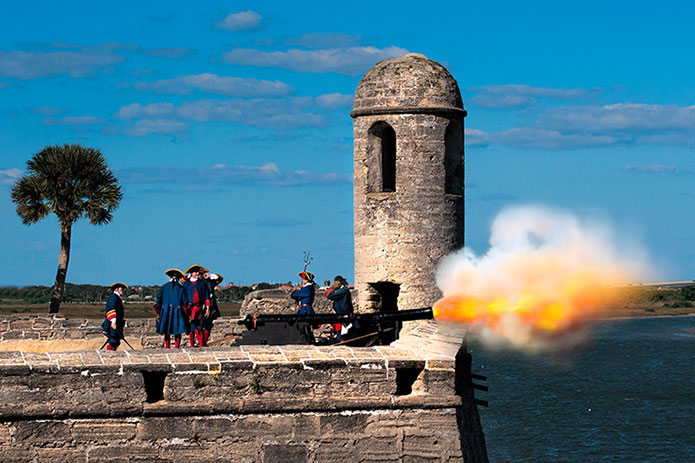
St. Agustine, a Melting Pot of Culture and Heritage
St. Agustine, a Melting Pot of Culture and Heritage
Located midway between Daytona Beach and Jacksonville, Florida’s Historic Coast includes historic St. Augustine...
September 30, 2017
St. Agustine, FL - by Hispanicize Wire - By the time the first English settlement in the new world was established at Jamestown, Virginia, St. Augustine had been a thriving coastal town for more than 40 years. Today this 451-year-old melting pot bubbles over with cultures near and far. The influence and history of Hispanics in St. Augustine has been profound and positive enriching every aspect of culture, bringing creativity and innovation to all aspects of this community. Recognized as Hispanic Heritage Month (Sept 15 – Oct 15), the United States celebrates Latin culture and makes it an ideal time to take a trip to discover St. Augustine – the place where the heart and soul of Hispanics heart was born and where it is alive and well today!
Spanish Discovery and Colonization
Spanish explorer Juan Ponce de Leon discovered and claimed Florida for Spain in 1513. But it wasn’t until 1565 when Pedro Menendez de Aviles founded the settlement of St. Augustine along with his crew of 800 men, women and children of Spanish, African and Greek descent.
Today’s Fountain of Youth is the location of the actual first settlement of St. Augustine, which was the Indian Village of Seloy when Menendez came ashore. The first Spanish mission church was built on the adjacent grounds of the Mission Nombre de Dios, establishing the Nation’s first Catholic parish. The oldest structure in St. Augustine is the Castillo de San Marcos, built by the Spanish to defend the city from invaders.
The influence of Spanish history in St. Augustine is still evident today, more than four centuries later with historic buildings and attractions. It’s even reflected in the local cuisine.
Where to find multicultural culinary events, historic sites, tours and attractions
8th Annual St. Augustine Food & Wine Festival - October 1
Hosted by the St. Augustine Independent Restaurant Association, this festival takes place at the River House from noon-4 p.m. Enjoy culinary specialties from local restaurants and a beer garden as well as sample more than 100 wines. Tickets are $70. This event raises funds for the Boys and Girls Club of St. Augustine. 179 Marine St., St. Augustine 904-540-3129 www.staugustinerestaurants.com/food-wine-festival.
St. Augustine’s Restaurant Week - October 2-8
St. Augustine Independent Restaurant Association (SAiRA) is hosting a celebration of the local dining experience during this week. Foodies can take a tour of local cuisine from more than 12 independently owned SAiRA member restaurants located throughout St. Augustine. Chefs from each restaurant will prepare special, adventurous and delicious lunch and dinner menu experiences for participants. Dinner menu experiences are $35, and lunch menu experiences are $20. Participants can pick up a Restaurant Week Passport at any SAiRA member establishment listed on the website. Diners who receive passport stamps from five different restaurants throughout the week will receive a $25 SAiRA gift certificate. 904-429-4588 www.staugustinerestaurants.com/restaurantweek.
Castillo de San Marcos - This massive fortress, which took more than 20 years for the Spanish to build (1672- 1695), helped protect Spain’s treasure fleets from the English and pirates. It is the oldest masonry fort in the United States and was designated as America’s first national monument. https://www.nps.gov/casa/index.htm
Colonial Quarter - This 2-acre living history museum recreates St. Augustine’s storied past: 16th Century Spanish - The First City; 17th Century - Spanish Fortified Town; 18th Century - Spanish Garrison Town; 18th Century British - The 14th Colony. Visitors can explore the centuries and mingle with authentically costumed historic interpreters, participate in a musket drill, climb 35 feet to the top of a 17th century watchtower or sip on refreshments in the Taberna de Caballo, an intimate Spanish tavern. The Colonial Quarter
Fountain of Youth Archeological Park - Commemorating the founding of La Florida by Spanish explorer Ponce de Leon and his legendary search for the Fountain of Youth, archeologists have discovered that it is the actual site of the original Spanish settlement in St. Augustine of 1565. Spanish colonial military cannon firings, an authentic 16th century boat works, and exhibits demonstrating how the Spanish explorers navigated the seas are part of this classic experience in St. Augustine. http://fountainofyouthflorida.com/
Gonzalez-Alvarez House - “The Oldest House” was built in approximately 1702 and owned by a soldier named Tomas Gonzalez. In 1812, it was the home of St. Augustine mayor Geronimo Alvarez. Currently, the home is owned by the St. Augustine Historical Society and is open for public tours. http://www.saintaugustinehistoricalsociety.org/
Mission Nombre de Dios - On Sept. 8, 1565, Don Pedro Menendez de Aviles came ashore and founded St. Augustine, the first permanent European settlement in what is now the United States. On that date, Father Francisco Lopez offered the first Holy Mass here—a site that became the home of the first Catholic parish in the nation. Added last year was a beautiful museum that tells the story of the mission, called “the most sacred acre in America” by President John F. Kennedy. http://missionandshrine.org/
Plaza de la Constitucion - Established in 1573, the town square is named for its monument to the Spanish constitution of 1812. Soon after its erecting, when the monarchy was restored, all such monuments in Spanish territories were ordered to be destroyed. However, St. Augustine’s governor refused, and the original monument that stands here today is believed to be the only one remaining in the world.
Located midway between Daytona Beach and Jacksonville, Florida’s Historic Coast includes historic St. Augustine, the outstanding golf and seaside elegance of Ponte Vedra, and 42 miles of pristine, Atlantic beaches. For more information on events, activities, holiday getaways and vacation opportunities in St. Augustine, Ponte Vedra & The Beaches, go to the Visitors and Convention Bureau website at www.FloridasHistoricCoast.com, become a fan on Facebook or call 1.800.653.2489.
